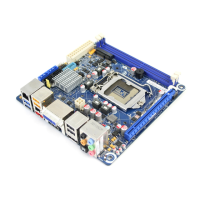
Do you have a question about the Intel DH77DF and is the answer not in the manual?
| Form Factor | Micro ATX |
|---|---|
| Socket Type | LGA 1155 |
| Chipset | Intel H77 |
| Memory Type | DDR3 |
| Memory Slots | 4 |
| Maximum Memory | 32 GB |
| SATA 6Gb/s | 2 |
| SATA 3Gb/s | 4 |
| Memory Speed | 1600/1333 MHz |
| USB 3.0 Ports | 2 |
| LAN | Intel 82579V |
| Graphics Output | HDMI, DVI, VGA |
| RAID Support | RAID 0, 1, 5, 10 |
| USB 2.0 Ports | 6 (4 Rear, 2 via internal header) |
Details on the board's AA revision, BIOS revision, and component specifics.
Information on known design defects or errors that may cause the product to deviate from specifications.
Provides a general introduction to the board's features, layout, and block diagram.
Summarizes the major hardware and software features of the Intel Desktop Board DH77DF.
Illustrates the location of major components on the top side of the motherboard.
Details the processor families supported and their specifications, including TDP.
Details the board's support for DDR3 SDRAM, including configurations, speeds, and capacity.
Explains the functions and interfaces managed by the Intel H77 Express Chipset.
Details the board's USB 3.0 and USB 2.0 port configurations and capabilities.
Describes the SATA connectors, speeds, RAID support, and mSATA slot.
Details the Intel HD Audio codec, features, and supported audio formats.
Explains the board's power management features, including ACPI and hardware support.
Discusses addressable system memory and the detailed system memory map.
Describes the board's back panel and component-side connectors and headers.
Illustrates and lists the connectors found on the back panel of the motherboard.
Shows the locations of connectors and headers on the top side of the motherboard.
Introduces the Intel BIOS, its storage, update capabilities, and setup program access.
Describes utilities for BIOS updates and media types for BIOS recovery.
Explains how to configure boot devices and adjust boot speed settings.
Covers supervisor and user password settings for BIOS setup and computer booting.
Lists and describes the BIOS beep codes indicating recoverable errors during POST.
Lists common BIOS error messages and explains Port 80h POST codes for diagnostics.
Details compliance with safety standards, EMC regulations, and product certifications.
Provides warnings and guidance on the proper disposal of used batteries according to local regulations.
